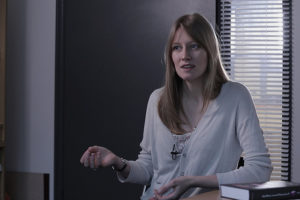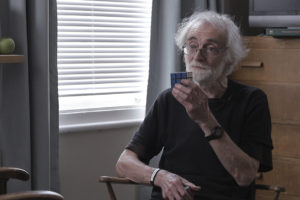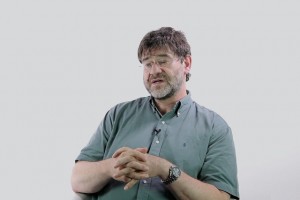Music in Perinatal Care
Psychoneuroimmunologist Daisy Fancourt on perception of sound by babies, mother-infant communication and music...
In November the 9th 1933 the great Austrian physicist Erwin Schrödinger came to this room, this office where I work, the office of the president of Magdalen College. Schrödinger had been in a Solvay Conference in Brussels; he came here and was admitted on that day as a fellow of Magdalen College using Latin phrases that we use to the present day. After the ceremony in this room the phone rang and it was from The Times of London. The Times of London said that Schrödinger had just been awarded the Nobel Prize. So he was heard he’d won the Nobel Prize in this room and the next day in The Times and The Telegraph newspapers it stated that Schrödinger of Oxford University had won the Nobel Prize even though he’d actually been employed before at the University of Berlin.

By Nobel foundation – http://nobelprize.org/nobel_prizes/physics/laureates/1933/schrodinger-bio.html, Public Domain
What did Schrödinger win the Nobel Prize for? Well, it was for a paper he wrote in 1926 when he introduced his famous Schrödinger equation. Up to that time, the theory for explaining the energy of electrons in atoms had really been due to the famous physicist Niels Bohr who’d come up with a theory for explaining the spectrum of the hydrogen atom, the electronic spectrum of the hydrogen atom and fitting the energy levels with his own formula. But Bohr’s theory didn’t work very well at all for other atoms or even for molecules: it didn’t seem to be a general one. What Schrödinger did is he came up with a general equation that worked for the hydrogen atom and worked for predicting not just the energy levels of the hydrogen atom but also the intensities of the spectral lines: whether the lines in the spectrum are intense or not, he could predict that intensity. That was new. Not even his collaborators or the people who were competing with him, like Heisenberg, knew how to do that and Schrödinger did it with his equation.
Then Schrödinger in the same year realized that he could apply his equation not just to the electronic energy levels of the hydrogen atom but to other problems, like the vibration of a harmonic oscillator, like to the rotation of a diatomic molecule: the same equation could be applied and gave the results that agreed with experiment for those sorts of problems. And then Schrödinger realized his equation could also be adapted not just for simple processes, but for processes that depend on time. In fact, there are two Schrödinger’s equations: what’s called ‘the time-independent equation’ and ‘the time-dependent equation’. But why the equation became so significant is that suddenly many scientists around the world realized that not only did it work for the hydrogen atom: it worked for all atoms and all molecules in principle. That means it had remarkable applications to nearly everything you can see, depends on atoms and molecules, and Schrödinger’s equation can be used to calculate all their properties. If you solve this equation very accurately, you get essentially the right answer. So it was a very powerful theory that came out of Schrödinger’s great work in 1926 for all atoms and molecules.
The problem is that his equation was quite complicated mathematically and very difficult to solve for anything more complicated than the hydrogen atom. Even for the helium atom, it involved quite a lot of difficult integration and differentiation and so on. So it didn’t really change science so much in the very early days. But where the big change came with Schrödinger’s equation was when computers came along: it was then possible to use computers to solve his equation and do that really accurately as time has gone on more and more. That means Schrödinger’s equation can be applied to more and more complicated systems and atoms, now to even to solid materials and also to problems of biological importance: you can do calculations with Schrödinger’s equation, for example, on proteins, on enzymes, on DNA and so on. So it’s become in the modern world an extremely powerful theory: it’s the theory that underlies the whole of chemistry, molecular biology. In material science, understanding the properties of materials, you can do calculations with Schrödinger’s equation and many people do that. Even in geology, you can calculate the temperature the centre of the Earth using variants of Schrödinger’s equation.
So in the 21st century, it’s become almost the essential tool for doing simulations on atoms and molecules. The other method before Schrödinger was developed by Isaac Newton: Newton’s laws. You could simulate atoms and molecules using Newton’s laws but those don’t include crucially quantum mechanical effects, such as tunnelling, such as probability: these laws just don’t work for atoms and molecules, but Schrödinger’s equation does.
So Schrödinger came here in 1933 and he came to work here in Oxford: he was a fellow in my college, he lectured at the University of Oxford on the quantum theory. But he wasn’t very happy here. He had an appointment which was almost like a postdoctoral assistant: after being a top professor in the University of Berlin he had an appointment that was just renewed every year, funded by ICI, the chemical company. So he wasn’t very happy. He was here just for three years and he missed his great friends in Berlin: he was very friendly with Max Planck, the person who discovered quantum theory. He was very friendly with Einstein who was also in Berlin in the 20s, so he missed his friends. In the end, he was unhappy here and after three years he decided to move back to his home country of Austria where he was given an appointment at the University of Graz in Austria and also another appointment at the University of Vienna and that’s where Schrödinger went.
He’d left Berlin in 1933 because he wasn’t very happy with the politics that was going on in Germany at the time. Science and politics in those days really intermixed. He didn’t like what the Nazis were doing, so he came to Oxford. But then he made the big mistake of going to Austria and he didn’t realize that there were going to be problems in Austria because Hitler’s troops marched in in 1938. Schrödinger had to escape from Austria. There was a worry he might even be arrested, but he managed to escape and he went to live in the Vatican for a short period and then he was contacted by the premier of Ireland, de Valera, who asked him to go and work in Ireland. So Schrödinger actually managed to come back here, to Magdalen College Oxford in 1938 and from there went to Ireland. He started at the Institute for Advanced Study in Dublin in Ireland and there he did another very important piece of work.
He was thinking about atoms and molecules and he realized that the fundamental principles of physics and chemistry, including his quantum mechanics, should be applied to the molecules of life, molecules like DNA and proteins which were just emerging at that time in the late 1940s. So Schrödinger wrote a small book in Dublin called ‘What is Life?’ that was stating that the basic principles of physics and chemistry could be applied to biology.
Now everybody knows that: the field of molecular biology is explained by these basic principles, but in those times people haven’t really thought about that. Some of the great young scientists of the time, such as Watson and Crick, read his book and thought: I better get into molecular biology, and that’s what they did. So you’ve got these great discoveries in the 1950s by people like Watson and Crick: the structure of DNA and then eventually after that RNA and other biological molecules. All of these were inspired by Schrödinger’s little book.
So he was a remarkable person setting up the basic quantum theory that underlies all the properties that we can observe essentially of atoms and molecules and also starting the revolution in molecular biology that we’ve seen to the present day. He was a hugely influential person. He wasn’t very popular: he wrote all of his papers essentially on his own. Nowadays you have big research groups; Schrödinger did it on his own. He was an individual person and never happy where he was. He wasn’t very happy here in Magdalen College Oxford, he did his original work actually in Zurich where he was just for a few years in the early 1920s, and he wasn’t in Ireland for that long.
After the Second World War, he decided to go back to Austria where he’d had the problems in the Hitler times. But he was welcomed back to Austria as a hero: they put his face on the banknotes and on the stamps, a crater on the Moon was named after him and he became one of the great people of Austria at that time. But we still remember him here in Oxford, we were very grateful that the great scientist Schrödinger came here. My own research is in quantum chemistry and that is solving Schrödinger’s equations for atoms and molecules and particularly for chemical reactions. So to me, he is my scientific hero, and as president of Magdalen College, I work in this room, the place where Schrödinger heard he’d won the Nobel Prize. That is really quite something.

Psychoneuroimmunologist Daisy Fancourt on perception of sound by babies, mother-infant communication and music...

Mathematician Gareth Jones on abelian and non-abelian groups, the symmetry of geometric objects and what are t...

Physicist Paul Hartogh on primordial materials, escape of the atmosphere, and the Giotto mission